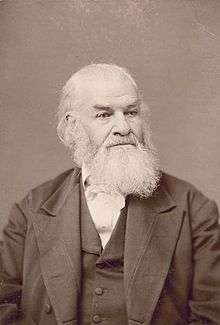Warren Chase
Warren Chase (January 5, 1813 – February 25, 1891) was an American pioneer, reformer, and politician. He served in the state senates of Wisconsin and California, and was a candidate for Governor of Wisconsin in the election of 1849.
Warren Chase | |
|---|---|
 | |
| Member of the Wisconsin Senate from the 4th district | |
| In office June 5, 1848 – January 9, 1850 | |
| Preceded by | Position Established |
| Succeeded by | John A. Eastman |
| Member of the California State Senate | |
| In office January 1880 – January 1883 | |
| Personal details | |
| Born | January 5, 1813 Pittsfield, New Hampshire |
| Died | February 25, 1891 (aged 78) Cobden, Illinois |
| Resting place | Cobden Cemetery Cobden, Illinois |
| Political party | Greenback (1882) Workingmen (1879) Free Soil (1849) Democratic (1848) |
| Spouse(s) |
|
| Children |
|
| Mother | Susanna Durgin |
| Father | Simon Chase |
| Profession | farmer, politician |
Early life and education
Chase was born in Pittsfield, New Hampshire, on January 5, 1813. He was the son of Susanna Durgin, who was unmarried at the time. His mother was maligned by the community and expelled from the church for giving birth out of wedlock, making it difficult to provide for herself and Warren. Warren's father was Simon Chase, who was married to Huldah Peaslee. Simon Chase fought in the War of 1812 and died at Plattsburgh in the fall of 1814, when Warren was not yet two years old. His mother died only a few years later, when Warren was five.[1]
As a child, Warren lived briefly with a Quaker family near Catamount Mountain. But after his mother's death, he became a ward of David Fogg and his family. Warren later described this time as a miserable experience and compared his servitude to slavery. Warren did not receive an education with the Fogg family and, at age fourteen was still not able to read or write. It was at that age he ran away to his grandmother's home in Pittsfield. Warren's grandmother and other members of the community interceded on his behalf and he was transferred to the care of his paternal grandfather, Nathaniel Chase, where he received a proper education and upbringing.[1]
In 1834 he moved to Monroe, in the Michigan Territory, and then, in 1838, he moved to the Wisconsin Territory, settling in Kenosha (then known as "Southport").
In Wisconsin
In the fall of 1843 the Franklin Lyceum of Southport began discussing the ideas of the French philosopher Charles Fourier and his American popularizer Albert Brisbane.[2] Convinced of the applicability of Fourier's "Associationist" prescription, Chase committed himself to the emerging movement without reservation, organizing a series of preliminary meetings to draft a constitution for a local "phalanx."[3]
On March 23, 1844, a formal meeting of phalanx supporters was held at the Southport village schoolhouse, officers were elected, and a group of three, including Warren Chase, were tapped as trustees of the phalanx.[4] A bond sale of $10,000 was approved and stock in the new enterprise began to be sold.[4] On May 8, 1844, they decided to purchase 1.25 sections (800 acres) of government land,[5] located in a valley between two gentle hills. By that fall a total of 1.5 sections (960 acres) were purchased[6] which would become Ceresco, Wisconsin (later merged into Ripon.
Chase helped found Ripon College. Chase was a supporter of the temperance, abolitionist, and spiritualist movements and wrote books and articles.
Chase served in the two Wisconsin Constitutional Conventions of 1846 and 1847 and was elected to the first Wisconsin Senate from Wisconsin Senate, District 4 as a Democrat.[7] In 1849, he was the candidate of the newly organized Free Soil Party for Governor of Wisconsin, coming in third behind Democratic incumbent Nelson Dewey and Whig Alexander L. Collins.
After Wisconsin
After the dissolution of the Wisconsin Phalanx, he moved to Michigan in 1853, then to Missouri, where he was elected as a Presidential elector in the 1872 United States presidential election. In 1876 he moved to California and settled in Santa Barbara, where he worked as editor of the Independent newspaper. While in California he was elected to the California State Senate on the Workingmen's Party ticket; it is unclear whether he agreed with the racist ideas of Workingmen's Party leader Denis Kearney, or merely with the party's anti-capitalist doctrines. He served on the California Senate from 1879 to 1882,[8][9] and lost his re-election bid as a Greenbacker. He later ran for Congress in California as a Greenback.
Death
Warren Chase died in Cobden, Illinois, in 1891, and was buried at Cobden Cemetery.[10][11][12][13]
References
- Chase, Warren (1868). The Life-line of the Lone One: Or, Autobiography of the World's Child. William White & Co.
-
- Samuel M. Pedrick, "Sketch of the Wisconsin Phalanx," Proceedings of the State Historical Society of Wisconsin at its 50th Annual Meeting held Dec. 11, 1902. Madison, WI: Wisconsin Historical Society, 1903; pp. 191-192.
- Pedrick, "Sketch of the Wisconsin Phalanx," pp. 192-193.
- Pedrick, "Sketch of the Wisconsin Phalanx," pg. 193.
- Pedrick, "Sketch of the Wisconsin Phalanx," pp. 193-194.
- Pedrick, "Sketch of the Wisconsin Phalanx," pg. 194.
- "Members of the Wisconsin Legislature 1848–1999 State of Wisconsin Legislative Bureau. Information Bulletin 99-1, September 1999. p. 4
- Tenney, H.A.; Atwood, David, eds. (1880). Memorial Record of the Fathers of Wisconsin. David Atwood. pp. 61–63.
- Chase, Warren 1813-1891
- Photograph of Warren Chase
- Warren Chase, Wisconsin Historical Society
- Warren Chase
- Biographical Profile, Ripon College
| Party political offices | ||
|---|---|---|
| Preceded by Party established |
Free Soil nominee for Governor of Wisconsin 1849 |
Succeeded by Edward D. Holton |